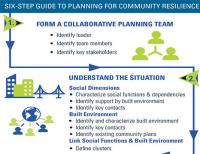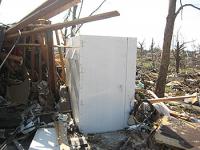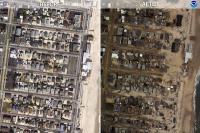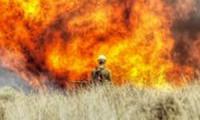-
Evaluating investments in community resilience

Communities weighing choices for capital improvement projects intended to improve their resilience to severe weather, wildfires, earthquakes, or other types of hazards now have a new guide to help them sort through the costs and benefits of each when deciding which investment is best for their particular circumstances. A new NIST report details steps for evaluating the “economic ramifications” of contemplated resilience investments as well as the option of maintaining the status quo.
-
-
Terror attacks in Paris and California expose modern society’s lack of resilience
Our complex global society lacks resilience. The root cause of our vulnerability is the structure of the global economy: highly interconnected, complex, and filled with turbulence. Major disasters can occur unexpectedly, and even minor incidents can cascade into significant human and financial losses. Emerging pressures such as climate change and urbanization will only intensify the potential for extreme events and severe disruptions. Risk management makes sense in a stable environment with predictable events, but in today’s more complex risk landscape — the new normal — it is inadequate for dealing with fast-moving, unfamiliar threats that may cascade into disasters. The good news is that brittleness is not inevitable. It is a fundamental design flaw. Resilience — the capacity to survive, adapt, and flourish in the face of disruptive change — is a basic characteristic of all living systems, from individual creatures to entire ecosystems. In this age of turbulence, resilience has become a prerequisite for continued prosperity.
-
-
First code improvements based on NIST Joplin tornado study adopted

Protecting schools and their associated high-occupancy buildings from the most violent tornadoes is the goal of the first approved building code changes based on recommendations from the National Institute of Standards and Technology (NIST) technical investigation into the impacts of the deadly tornado that struck Joplin, Missouri, on 22 May 2011. The new changes, approved at a recent meeting of the International Code Council (ICC), apply to the nation’s most tornado-prone regions.
-
-
Blitz spirit needed to meet challenges like climate change: Dr. Hugh Hunt
Today’s engineers will need the kind of drive and determination shown by the great wartime innovators such as Sir Barnes Wallis and Sir Frank Whittle if they are to respond effectively to challenges such as climate change, Dr. Hugh Hunt told the Royal Academy of Engineering on Tuesday. Hunt compared today’s challenge of adapting to future climate change with the imperative to develop new technologies to tip the balance of military capability in favor of the Allies during the Second World War.
-
-
FEMA paid $250 million in duplicate benefits after Hurricane Sandy: DHS IG
The Department of Homeland Security’s Office of Inspector General (OIG) says it used “innovative data matching tools” to determine that the Federal Emergency Management Agency (FEMA) paid approximately $250 million in disaster assistance to more than 29,000 Hurricane Sandy applicants who may have received duplicate benefits from their private insurers.
-
-
FEMA funding for post-Sandy recovery in New Jersey exceeds $6.8 billion

In the three years since Hurricane Sandy scored a direct hit on New Jersey, FEMA has provided $6.8 billion to date to help the state recover and rebuild. FEMA Public Assistance, which provides funds for repair and rebuilding of infrastructure and public facilities as well as necessary work such as debris removal and emergency response, has obligated $1.809 billion in Public Assistance funds towards repair and rebuilding projects in New Jersey.
-
-
FEMA aid for New York’s Hurricane Sandy recovery reaches $16.9 billion
FEMA and the U.S. Small Business Administration have disbursed nearly $16.9 billion for New York’s recovery since Hurricane Sandy made landfall on the East Coast three years ago. FEMA said that this amount includes more than $1 billion paid directly to survivors for housing and other essential needs through the Individuals and Households Program which ended 30 April 2014.
-
-
Pipeline replacement programs are effective
Aging infrastructure, including roads, bridges, and natural gas and water mains, is an increasing concern. In 2011 the U.S. Pipeline and Hazardous Materials Safety Administration issued a call to action to accelerate the repair, rehabilitation, and replacement of the highest-risk pipeline infrastructure. Invisible gas leaks from aging or damaged pipelines cost U.S. consumers billions of dollars every year, contribute to global warming and, in rare cases, cause dangerous explosions. Pipeline replacement programs in cities, however, can cut natural gas leaks by 90 percent, a new study finds. “The surprise wasn’t that replacement programs worked,” said the study’s lead author. “It was that they worked so well.”
-
-
NSF awards $27.5 million in hazards research grants
Wildfires raged through Idaho, Washington, Oregon, and California this summer, taking the lives of firefighters and forcing thousands to flee their homes. Months earlier and half a world away, another disaster struck when a magnitude 7.8 earthquake in Nepal resulted in thousands of deaths, hundreds of thousands left homeless and entire villages flattened. How can societies better predict or prevent such catastrophes? How can they help people recover more quickly from disasters?
-
-
Interior Dept.’s National Seed Strategy to guide post-disaster rehabilitation, restoration

As part of what it describes as a comprehensive, science-based strategy to address the threat of wildfires that are damaging landscapes across the West, the Department of the Interior announced the release of a National Seed Strategy for rehabilitation and restoration to help foster resilient and healthy landscapes. The strategy is meant to guide ecological restoration across major landscapes, especially for those lands damaged by rangeland fires, invasive species, severe storms, and drought.
-
-
Interior Dept.’s National Seed Strategy to guide post-disaster rehabilitation, restoration
As part of what it describes as a comprehensive, science-based strategy to address the threat of wildfires that are damaging landscapes across the West, the Department of the Interior announced the release of a National Seed Strategy for rehabilitation and restoration to help foster resilient and healthy landscapes. The strategy is meant to guide ecological restoration across major landscapes, especially for those lands damaged by rangeland fires, invasive species, severe storms, and drought.
-
-
Safer structures to withstand earthquakes, windstorms
A new cyberinfrastructure effort funded by a $13.7 million grant from the National Science Foundation will help engineers build safer structures that can better withstand natural hazards such as earthquakes and windstorms. Researchers aim to build a software platform, data repository, and tools that will help the United States design more resilient buildings, levees, and other public infrastructure that could protect lives, property and communities.
-
-
Social engagement helps in disaster preparedness
People who participate in social activities in their community are more likely to plan and prepare for future disasters, such as tsunamis, according to a new study. The study was based on household surveys in tsunami-prone areas of Phang Nga, Thailand, a region which was hard hit by the 2004 Indian Ocean Tsunami, and which has been active in setting up tsunami early warning systems and disaster training programs.
-
-
We need to change how and where we build to be ready for a future of more extreme weather
The human and economic losses resulting from extreme weather events during the last several years vividly demonstrate the U.S. historically shortsighted approach to development. The ill-advised, fast-paced construction of human settlements in low-lying, coastal and riverine environments prone to flooding has long been the American way. From Galveston to Hoboken, we have laid out our grids and thrown up our houses with little regard for the consequences. Storms like Sandy are a harbinger of extreme weather events to come as a result of climate change. Without concerted action, the costs, in lives and property, of future weather events will only multiply. Rather than spending $25 million on PR campaigns to convince ourselves we’re “stronger than the storm,” we should start making choices that prove we’re smarter. For while we can’t say when the next hurricane with the force of Sandy (or even greater force) will batter the Atlantic Coast or when extreme flooding will hit Texas, we do know that there will be a next time. And we’re still fundamentally unprepared for it. We can’t continue to bet against climate change; we’ll lose in the end.
-
-
Gifts of cash may be best way to rebuild lives of disaster victims
Historically, the orthodox approach to helping people in humanitarian emergencies has been to give them things – food, water, hygienic supplies and so on. There’s an argument for this approach, but also a very real risk: that we give people the wrong things. And the network of contractors and subcontractors often used to administer this “in-kind” aid is sufficiently complex and opaque that we can’t really tell how we’re performing. As researchers have begun conducting rigorous experimental tests of anti-poverty strategies (“randomized controlled trials”), seeking reliable answers to the question “what works?” a consistent finding has been that simply giving money directly to individuals works quite well. Multiple studies have found that when people in need receive cash and the freedom to spend it as they choose, the results are impressive.
-
- All
- Regional
- Water
- Biometrics
- Borders/Immig
- Business
- Cybersecurity
- Detection
- Disasters
- Government
- Infrastructure
- International
- Public health
- Public Safety
- Communication interoperabillity
- Emergency services
- Emergency medical services
- Fire
- First response
- IEDs
- Law Enforcement
- Law Enforcement Technology
- Military technology
- Nonlethal weapons
- Nuclear weapons
- Personal protection equipment
- Police
- Notification /alert systems
- Situational awareness
- Weapons systems
- Sci-Tech
- Sector Reports
- Surveillance
- Transportation
Advertising & Marketing: advertise@newswirepubs.com
Editorial: editor@newswirepubs.com
General: info@newswirepubs.com
2010-2011 © News Wire Publications, LLC News Wire Publications, LLC
220 Old Country Road | Suite 200 | Mineola | New York | 11501
Permissions and Policies
Editorial: editor@newswirepubs.com
General: info@newswirepubs.com
2010-2011 © News Wire Publications, LLC News Wire Publications, LLC
220 Old Country Road | Suite 200 | Mineola | New York | 11501
Permissions and Policies
